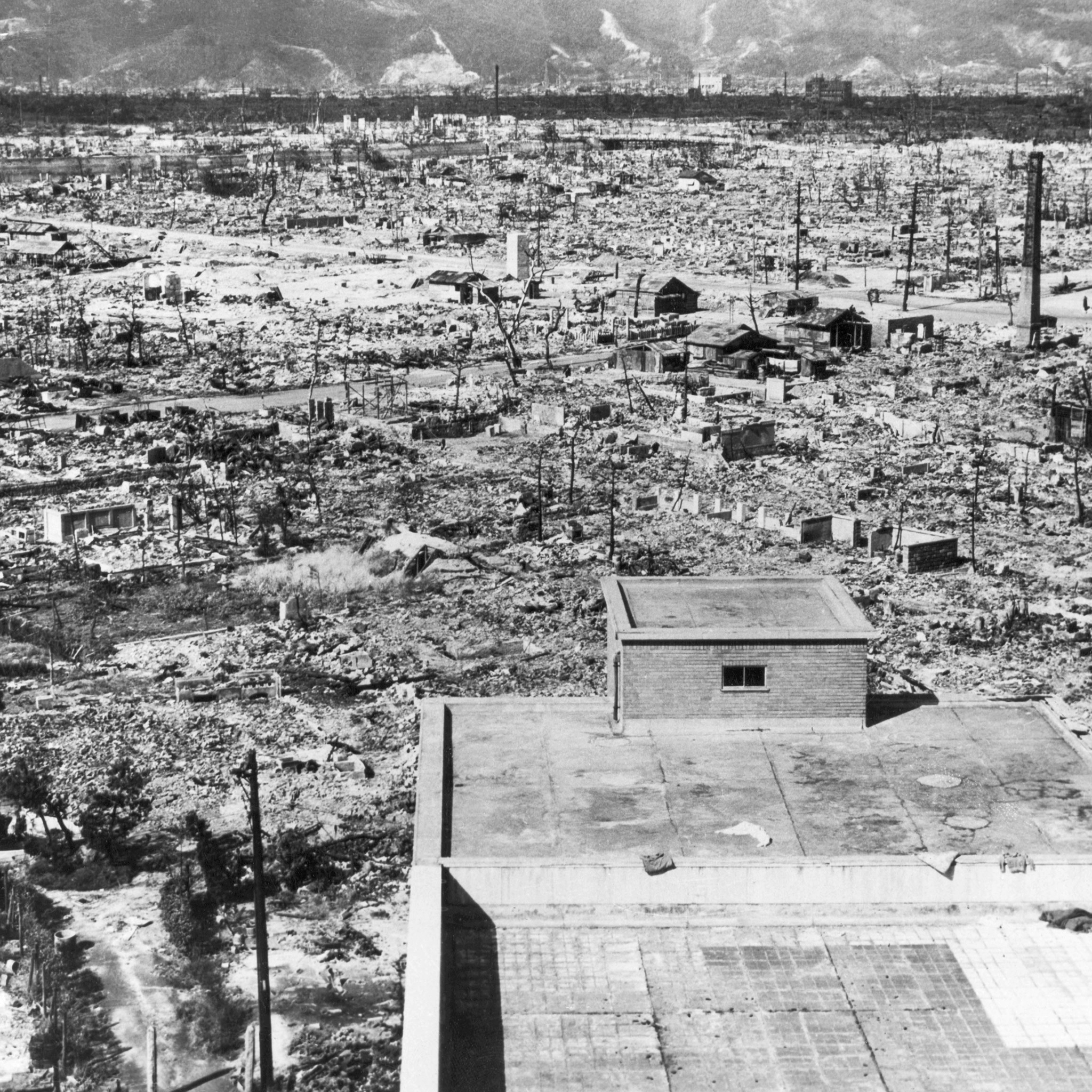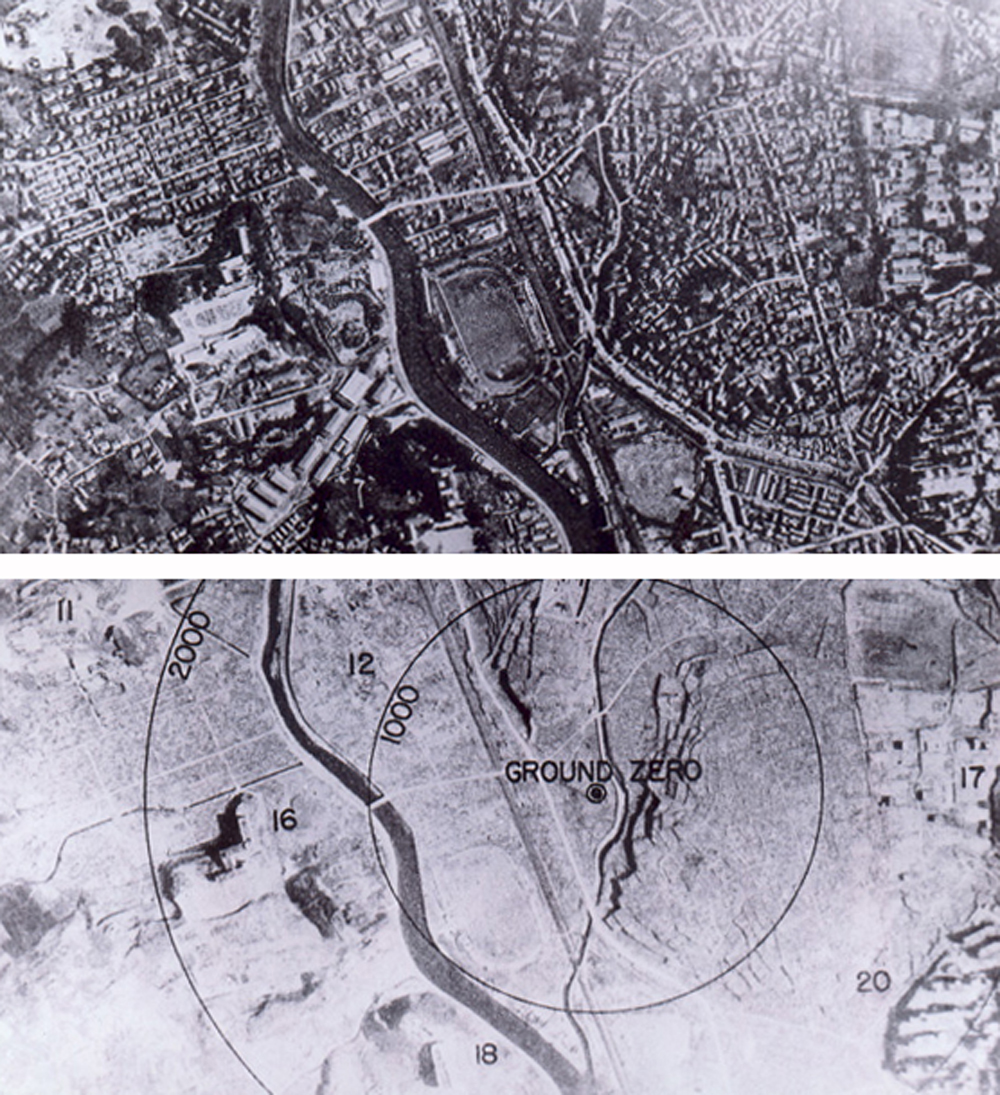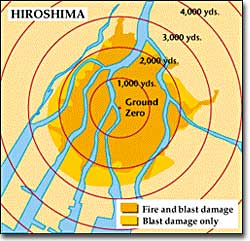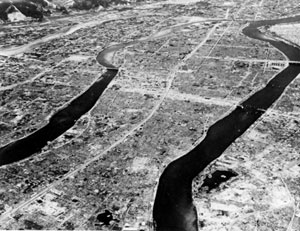
The Destruction of Hiroshima
Topics on the Page
Reasons for Dropping the Atomic Bomb
The Decision to Use the Atomic Bomb
Women and the Atomic Bomb
Racism Toward Japanese Peoples
Lasting Effects
![]() CROSS-LINKS
CROSS-LINKS
The Manhattan Project and the Atomic Bomb
- This interactive map allows a student to select an area around the world, choose one of the 30 bombs that have been used in history, and model the blast zone and affected radius that accompanies. Humanizes the affects of an atomic bomb, by putting into context the lives that would be lost in such an occurrence.
|
PAGE SUMMARY This page discusses the debate surrounding the controversial bombing of Hiroshima and Nagasaki. It provides the reasons for the dropping of the bomb. This includes the estimated death tolls, the demonstration of superior weaponry, and the ending of the war. This page also describes the death and destruction caused by the bomb. This page also describes the complicated process of making the decision to use atomic weapons. (Katelyn Maskell, April 2022) |
Reasons for dropping the atomic bomb
Government issued reasoning
The reasoning provided by the United States government as to why they bombed Japan is that it would save a sizable number of American lives by convincing the Japanese to surrender prior to the Allied forces' planned invasion of the Japanese mainland.
Such an operation was expected to be extremely difficult and to result in massive Allied casualties due in part to the nationalistic fanaticism of Japanese fighters. 
President Truman's projection of American deaths and the projections of other top officials varied significantly, from 250,000 to over a million.
Bombing Japan was expected to...
- show demoralizing effect of the superior weaponry
- prevent the death of more of their civilian population
- the destruction of urban areas and infrastructure
Thus ending the war more quickly and preventing American deaths. This is the dominant theory taught in schools and believed by most Americans.
A Draft Statement on the Dropping of the Bomb, July 30, 1945 - this report demonstrates the thought process of government officials who were in support of dropping the bomb and displays key language used to convince others.
![]() The details of this theory are laid out in the Harper's Magazine article "The decision to use the atomic bomb" by Secretary of War Henry L. Stimson.
The details of this theory are laid out in the Harper's Magazine article "The decision to use the atomic bomb" by Secretary of War Henry L. Stimson.
The Atomic Heritage Foundation has compiled a timeline of the preparations and events leading up to the Bombings, the events of the day of first bombing, August 6th, and up until Japanese officials signed terms of surrender on September 2nd.
 |
| Nagasaki 1945 - Before and After |
Atomic Diplomacy
There are a number of historians and theorists who believe that the bombing of Japan was unnecessary to win the war and was intended to intimidate the Soviet Union, whom the US predicted would be its main adversary on the global stage following the war.
Click here to read about and watch a scholarly debate over the teaching of the bombing of Hiroshima and Nagasaki.
![]() A deconstruction of Stimson's article is available in Gar Alperovitz' revisionist history The Decision To Use the Atomic Bomb and the Architecture of an American Myth.
A deconstruction of Stimson's article is available in Gar Alperovitz' revisionist history The Decision To Use the Atomic Bomb and the Architecture of an American Myth.
- Alperovitz argued that the Japanese had been planning to surrender prior to the use of the atomic bombs. However, while they had been prepared to offer a conditional surrender wherein the Emperor of Japan - held by die hard nationalists to be a divine being - would remain untouched, Truman and his administration refused to accept anything but an unconditional surrender.
Critics have accused the Truman administration of having been fully aware of the Japanese offers of surrender being intentionally unreasonable in order to make the use of the atomic bombs appear necessary. This would have been useful as a means of intimidating the Soviet Union with this revolutionary weaponry while also winning the war in the Pacific Theater prior to the USSR's planned involvement, hence denying them any influence in the rebuilding of Japan.
This would make the new Japanese government the product of Western influence exclusively and avoid a situation such as that in Europe, which was being divided between the capitalist Western powers and communist Soviets after the war. In short, the use of atomic weapons in Japan was a major development in the beginning of the Cold War because it established a significant foothold for Western - and particularly American - economic and ideological influences in the East.

The Decision to Use the Atomic Bomb
Harry Truman's Decision to Use the Atomic Bomb
![]() For documents related to President Truman's decision made available from the Truman Presidential Library.
For documents related to President Truman's decision made available from the Truman Presidential Library.
An online version of the debate is located here. (note: a combination of these two sources is an excellent lesson in primary sources, master narratives and revisionist history, and how they work together). For further expostulation on this theory, read an excerpt of modern scholar Roland Takaki's article here, which notes that even General Douglas MacArthur considered the operations "completely unnecessary" and President Harry Truman struggled mightily with the decision in private and among his closest cabinet advisors.
![]() Click here for a U. S. War Department film on the bombing on Japanese cities
Click here for a U. S. War Department film on the bombing on Japanese cities

This link provides a greater overview of the events leading up to the dropping of the atomic bomb
Click here for a New York Times article that describes the history of the debate surrounding the atomic bomb.
![]() The Women Behind the Bomb
The Women Behind the Bomb
Nearly 640 women contributed at Los Alamos during World War II
Book: The Girls of Atomic City: The Untold Story of the Women Behind the Bomb

Racism Toward Japanese People
Most political theories about the dropping of the atom bomb neglect to include the fierce anti-Japanese sentiment that was present in the United States during the war.
Why Japan? The Racism of the Hiroshima and Nagasaki Bombings details how intimately racism was tied into the bombing of Hiroshima and Nagasaki.
- Much of the language used by Truman and other government officials at the time dehumanized the Japanese based on their race and their tenacious, seemingly animalistic, fighting style.
The effects of Hiroshima and Nagasaki for the Japanese people:
- Testimonies from Japanese civilians who have been affected by the Hiroshima and Nagasaki bombings
The Dropping of the Atomic Bomb
Essay delving into the reasons behind the dropping of the nuclear bomb. Racism, prejudice and the inevitable surrender. Melissa argues the use of nuclear weapons changed the world forever at the cost of many innocent civilians lives.
![]() For more on western racism toward Asians, see Hiroshima: Why America Dropped the Atomic Bomb. Ronald Takaki, 1996.
For more on western racism toward Asians, see Hiroshima: Why America Dropped the Atomic Bomb. Ronald Takaki, 1996.
In Dr. Seuss Goes to War, historian Richard Minear explains how some of Dr. Seuss' wartime political cartoons demonstrate the extreme racism toward the Japanese during the war. See this online catalog of these cartoons.
Ultimately, no one has provided a definitive answer as to why exactly the United States dropped the atomic bombs on Japan.
![]() A number of documents on both sides of the debate over the atomic bomb are located here.
A number of documents on both sides of the debate over the atomic bomb are located here.
Lasting Effects
The atomic bombs killed hundreds of thousands of people the day they were dropped, but they also caused long-term health effects that lasted for decades. Click here for an article detailing the long term health implications of using atomic bombs in warfare.
Interview with Daniel Ellsberg, former US military analyst and infamous whistleblower of the Pentagon Papers, explaining the history of US bombing, including Hiroshima/Nagasaki, and the continued threat of nuclear war.